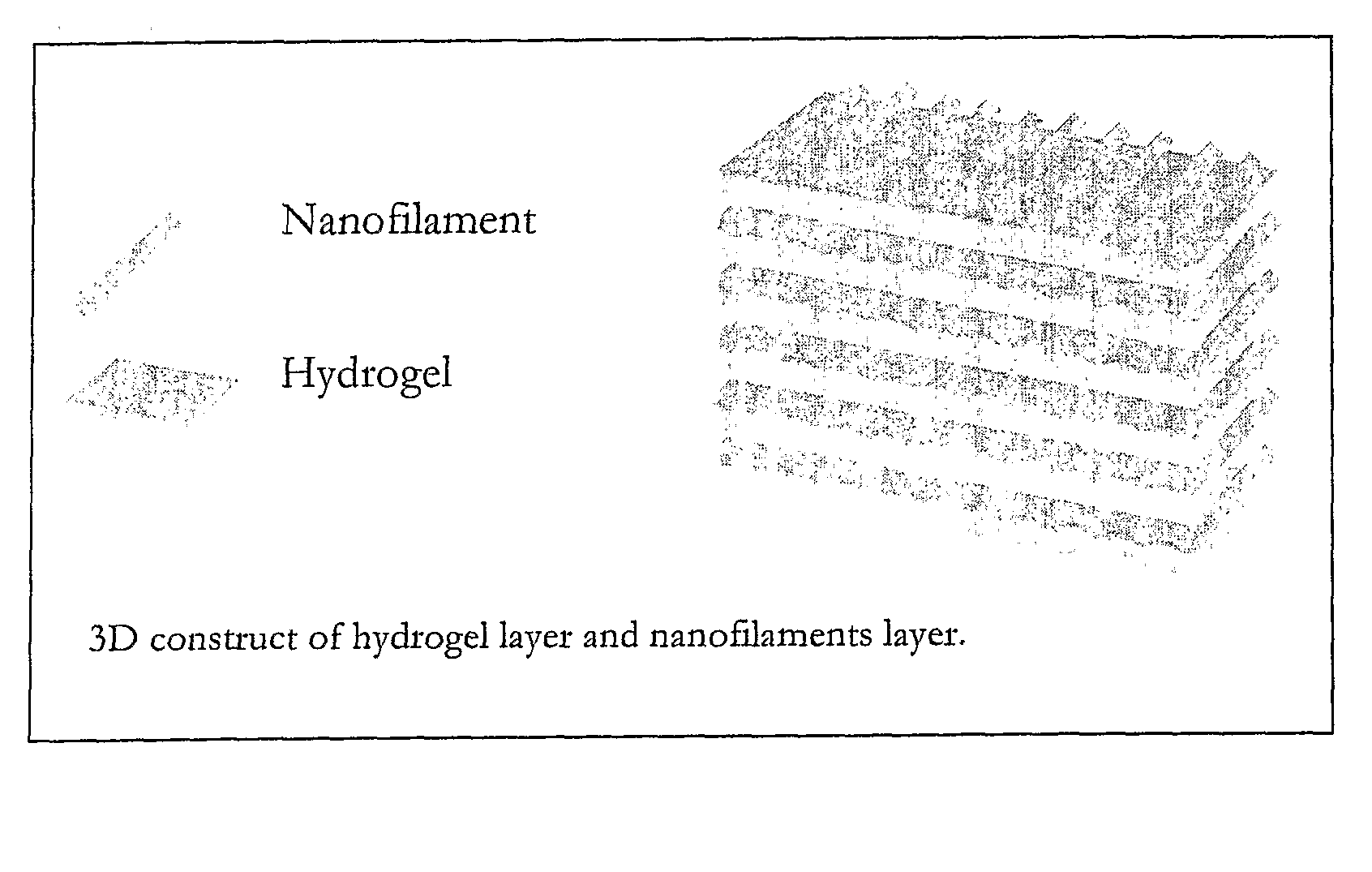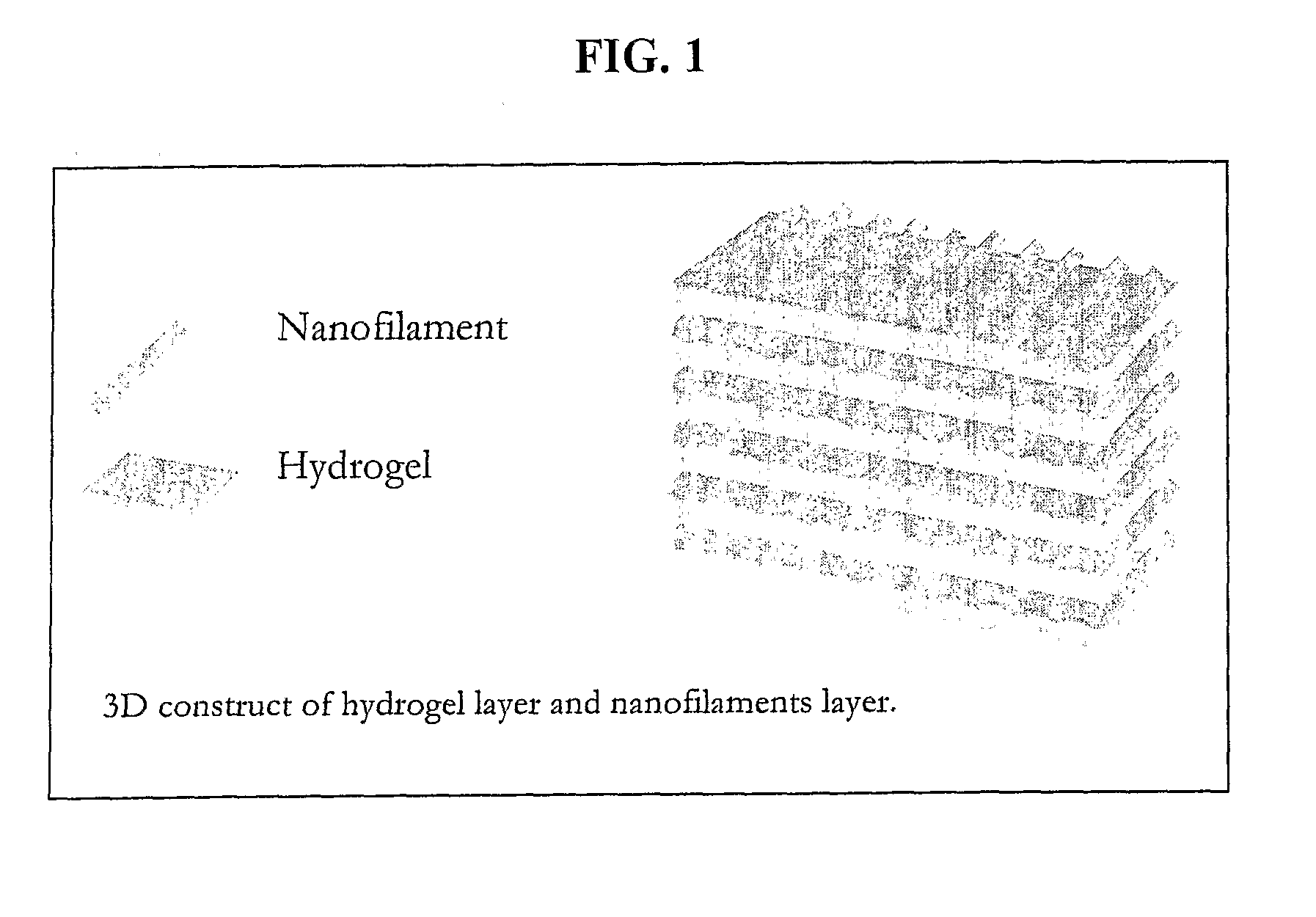Nanofilament Scaffold for Tissue Regeneration
a tissue regeneration and nano-filament technology, applied in the field of tissue engineering, can solve the problems of lack of co-adaptation, gap between two nerve stumps, and limited use of autografts
- Summary
- Abstract
- Description
- Claims
- Application Information
AI Technical Summary
Benefits of technology
Problems solved by technology
Method used
Image
Examples
example 1
Method of Making Oriented Nanofiber Films by Electrospinning
[0044]Uniaxially oriented nanofiber films were fabricated by electrospinning poly (acrylonitrile-co-methylacrylate, random copolymer, 4 mole percent of methacrylate) (PAN-MA) on a high speed rotating metal drum. An 18% (w / v) PAN-MA solution was prepared in an organic solvent, N,N-Dimethyl Formamide (DMF) at 60° C. The polymer solution was loaded into a 10 mL syringe and delivered at a constant flow rate (1 mL / hour) to a 21 gauge metal needle connected to a high voltage power supply. Upon applying a high voltage power supply of about 13 kV to about 18 kV, a fine jet of polymer solution was ejected from the needle and deposited on a thick aluminum foil wrapped around the high speed rotating metal drum. The foil carrying the aligned electrospun nanofiber film was then removed and stored at room temperature. The nanofiber film was approximately 10 μm thick and composed of nanofibers with diameters in the range of about 400 nm t...
example 2
Three-Dimensional Oriented Nanofiber Scaffold
[0045]An oriented, 3-D nanofiber scaffold was created by stacking the uniaxially oriented nanofiber films made as described in Example 1. A total of 15 nanofiber films were cut into 17 mm×1 mm pieces, removed from the aluminum foil, and stacked so that the orientation of the nanofibers aligned with the axis of regeneration within two halves of a longitudinally split polysulfone nerve conduit (Koch Membrane Systems, 50,000 MW cutoff—19 mm long, 1.5 mm inner diameter). The longitudinal half-cut was closed and sealed using UV light curing adhesive. See FIG. 4. The nanofiber scaffold was sterilized by soaking it in a 70% ethanol solution for 30 minutes and washing it three times with sterilized deionized water. The nanofiber scaffold was stored in sterilized PBS until implantation. FIG. 2 shows representative photograph of a single nanofiber film, stacked films, and a three-dimensional nanofiber scaffold.
example 3
In Vivo Nerve Tissue Growth Using Oriented, 3-D Nanofiber Scaffold
[0046]The nanofiber scaffolds fabricated as described in Example 2 were implanted into a transected tibial nerve of adult male rats. Autograft implants and saline filled nerve conduit implants were also tested in comparator / control animals.
[0047]Double immunostaining (axons and Schwann cells) revealed that the implanted nanofiber scaffolds facilitated the regeneration of transected tibial nerves across 17 mm nerve gaps, and that host derived Schwann cells infiltrated the nanofiber scaffolds from both proximal and distal stumps of the nerve. The transected axons entered into the proximal end of the nanofiber scaffolds, regenerated through entire length of the nanofiber scaffold along the nanofiber films, and moved into the distal stump of the nerve. This successful regeneration was observed in all nanofiber scaffold treated animals (n=12). The regenerating axons always co-localized with the aligned Schwann cells throug...
PUM
| Property | Measurement | Unit |
|---|---|---|
| diameter | aaaaa | aaaaa |
| diameter | aaaaa | aaaaa |
| thickness | aaaaa | aaaaa |
Abstract
Description
Claims
Application Information
 Login to View More
Login to View More - R&D
- Intellectual Property
- Life Sciences
- Materials
- Tech Scout
- Unparalleled Data Quality
- Higher Quality Content
- 60% Fewer Hallucinations
Browse by: Latest US Patents, China's latest patents, Technical Efficacy Thesaurus, Application Domain, Technology Topic, Popular Technical Reports.
© 2025 PatSnap. All rights reserved.Legal|Privacy policy|Modern Slavery Act Transparency Statement|Sitemap|About US| Contact US: help@patsnap.com



